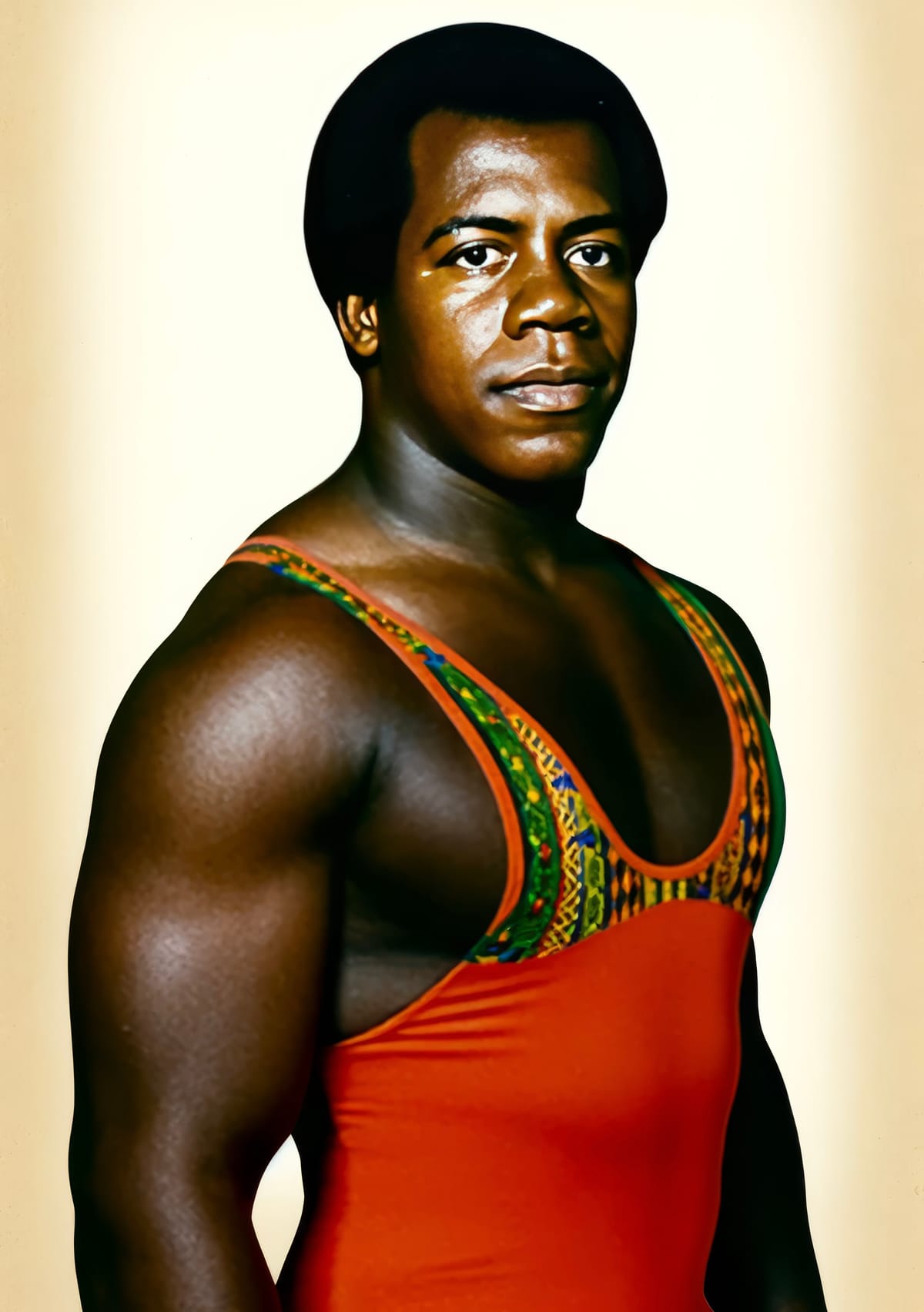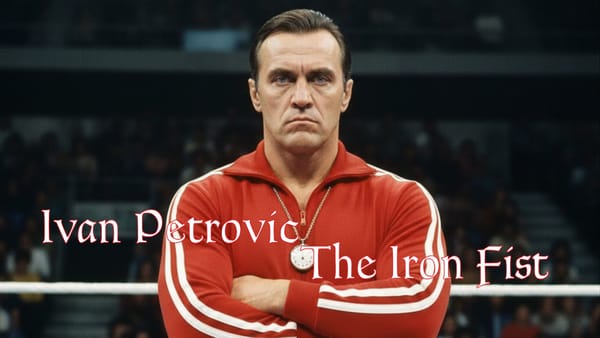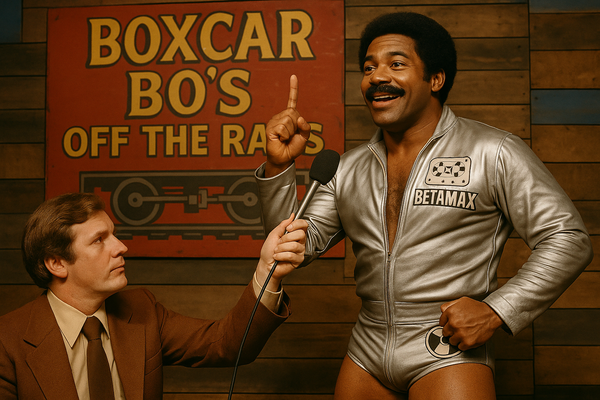"The Viper" Vic Steele

Early Life and Background
In the tough streets of Compton, California, during the late 1950s, young Victor Steele faced a world where opportunities were scarce, and the struggle for survival was a daily reality. Growing up in a predominantly African-American neighborhood, Steele was no stranger to hardship. His father, a former boxer who never made it past the local circuits, worked multiple jobs to provide for the family, while his mother took on domestic work, instilling in Steele a sense of resilience and determination.
From an early age, Victor exhibited a natural athleticism and a fierce competitive spirit. These traits were evident in schoolyard scuffles and impromptu wrestling matches with neighborhood kids. However, the streets of Compton were unforgiving, and Steele quickly learned that physical strength was not enough to navigate the challenges he faced. His father, seeing potential in his son, began to train him in the basics of boxing and wrestling, hoping to channel his energy and talent into something constructive.
As Steele grew older, the social climate of the early 1960s became more turbulent. The Civil Rights Movement was in full swing, and racial tensions were high. Steele's experiences with discrimination and injustice fueled his drive to prove himself, to rise above the limitations imposed by society. He found solace and a sense of purpose in the wrestling ring, where he could channel his frustrations and aspirations.
In high school, Steele joined the wrestling team, quickly becoming a standout athlete. His fierce determination and raw talent caught the attention of local scouts. Wrestling provided him with a refuge from the systemic racism and economic hardships that plagued his community. It was a place where he could exert control and gain respect, even if it was hard-earned.
By the time he graduated, Steele had made a name for himself in local wrestling circuits. However, breaking into professional wrestling was a different beast altogether. The industry was dominated by white wrestlers, and African-Americans often faced significant barriers. Undeterred, Steele continued to hone his skills, participating in underground matches and earning a reputation for his relentless fighting style.
In 1965, his big break came when a scout from the Great Western Wrestling Alliance (GWA) saw him in a local match. Impressed by his prowess and undeniable presence, the scout offered him a chance to join the GWA. Steele knew this was his opportunity to rise above his circumstances and make a name for himself on a larger stage.
Entering the GWA as "The Viper," Steele embraced his role as a heel, using his cunning and aggressive tactics to carve out a place for himself. His early years in the GWA were marked by intense hostility from fans who were unaccustomed to a black wrestler playing a prominent role. Steele channeled the prejudice and disdain into fuel for his performances, snarling at the crowd and embodying the ruthless persona of "The Viper."
Despite the challenges, Steele's talent and determination could not be denied. His unique blend of brute strength and tactical precision, combined with his ability to play the crowd, set him apart. Each match was a battle not just against his opponent but against the societal barriers that sought to keep him down.
Steele's early life and upbringing, marked by resilience, familial support, and a burning desire to rise above his circumstances, laid the foundation for his legendary career. His journey from the streets of Compton to the heights of professional wrestling was a testament to his indomitable spirit and the transformative power of sport.
Rise to Fame in GWA
In the gritty, unforgiving streets of Compton, California, a young Vic Steele learned the hard way that survival meant standing tall against all odds. With an unyielding spirit and a natural talent for wrestling, Steele caught the eye of GWA scouts. In 1965, he entered the world of professional wrestling, a realm where he would soon carve out a legacy as one of the most formidable competitors ever to grace the ring.
Steele's early days in the GWA were marked by fierce hostility from fans. As one of the few African-American wrestlers in the league, he faced a torrent of racial prejudice. The boos and jeers only fueled his determination. Embracing his role as a heel, Steele became "The Viper," a moniker that reflected his cunning and relentless nature. He snarled at fans, a defense mechanism against the rejection he anticipated.
His matches were brutal, characterized by his unique blend of brute strength and tactical precision. Steele quickly earned a reputation for his devastating signature moves, like the Viper Strike and the Serpent's Coil. Yet, despite his prowess, the crowd's disdain lingered, a constant reminder of the barriers he had yet to overcome.
Then came August 1972, a night that would forever change Steele's career. The event was the Soul Power Olympic Brawl, and Steele was pitted against the beloved "Big Sky" Billy Thompson. It was a match few believed Steele could win, a David versus Goliath scenario with a twist. As the match progressed, something unexpected happened. The crowd, initially chanting "Billy! Billy!" began to shift. Steele's relentless performance, his undeniable skill, started to win them over. The chants morphed into "Viper! Viper!" and then, astonishingly, "Victor! Victor!"
This moment was a revelation for Steele. The acceptance and support from the crowd ignited a change within him. The victory over Thompson was more than a win; it was a breakthrough. For the first time, Steele felt the fans' respect, a validation of his journey and struggles. He credited Harlem Hurricane, a fellow African-American wrestler who won the Intercontinental Title that night, for believing in him and helping him secure a spot on the card.
Following this pivotal match, Steele's approach began to evolve. He joined Prof. Langston's World-Renowned Squabble Squad from 1976 to 1978, a group of wrestlers known for their honor and skill. Steele's time with the Squabble Squad saw him adopting a more respectful demeanor, quietly acknowledging fans and opponents alike. His transformation was complete when he captured the GWA Pacific Coast Championship in early 1978, holding the title for two months.
Steele's career continued to ascend as he formed the "Serpentine Fire" tag team with The Serpent Twins from 1981 to 1983. This period was marked by thrilling matches and memorable performances, solidifying Steele's status as a legend in the GWA. His influence extended beyond the ring as he became a vocal advocate for overcoming adversity, using his platform to inspire others.
Through resilience and unwavering determination, "The Viper" Vic Steele rose from the streets of Compton to the pinnacle of professional wrestling. His journey was not just about personal triumph but about breaking barriers and changing perceptions. Steele's legacy in the GWA is a testament to his strength, skill, and the indomitable spirit that defined his career.
Signature Moves and Style
In the dimly lit arenas of the Great Western Wrestling Alliance, "The Viper" Vic Steele was a force of nature, his presence alone enough to send shivers down the spines of his opponents. His fighting style, a masterful blend of brute strength and tactical precision, set him apart from the rest. Every match was a psychological chess game, with Steele always two steps ahead, ready to strike when his opponents least expected it.
Steele's movements were deliberate and powerful, each step a calculated decision. He had an uncanny ability to read his opponents, exploiting their weaknesses with ruthless efficiency. His background, steeped in the struggle and resilience of overcoming adversity, was evident in his unyielding tenacity. Steele fought with a chip on his shoulder, a constant reminder of the battles he'd faced outside the ring.
When the bell rang, fans knew they were in for a spectacle. Steele's signature moves were the stuff of legend, each one designed to showcase his immense strength and strategic prowess.
First, there was the Viper Strike. As his opponent regained their footing, Steele would suddenly explode into motion, delivering a devastating running clothesline. The impact was bone-crushing, often catching his adversaries off guard and sending them crashing to the mat.
Then there was the Serpent’s Coil, a punishing submission hold that left his opponents gasping for breath. Steele would wrap his powerful arms around his opponent's neck and torso, squeezing with relentless pressure. It was a test of endurance, a demonstration of Steele's formidable strength and a reminder of the snake-like grip from which his moniker derived.
When it was time to finish the match, Steele would unleash the Venom Drop. Hoisting his opponent high into the air, he would slam them down with a thunderous powerbomb. The move was a testament to his raw power and often led to a swift pinfall, asserting his dominance in the ring.
The Cobra Clutch was another weapon in Steele’s arsenal. A variation of the sleeper hold, this move saw Steele applying intense pressure to his opponent’s neck and shoulders, cutting off their air supply. It was a slow, methodical maneuver, showcasing his technical skill and psychological acumen.
Finally, there was the Snake Bite—a quick, ruthless punch to the gut followed by a crushing uppercut. This combo move was designed to disorient and weaken his opponents, setting them up for one of Steele's more powerful attacks.
Steele's unique fighting style and signature moves made him a formidable opponent. His blend of strength, strategy, and psychological warfare secured his victories and cemented his legacy as one of the most feared and respected wrestlers in GWA history.
Ring Entrance
When "The Viper" Vic Steele made his way to the ring, the atmosphere in the arena would transform. The lights would dim, casting the crowd in shadow, while a single spotlight illuminated the entrance ramp. The haunting bassline of "Papa Was a Rollin' Stone" by The Temptations would begin to play, its eerie, soulful tones reverberating through the venue, creating a sense of anticipation and unease.
Steele emerged from the shadows, his powerful frame and intense expression catching the light. Clad in a vibrant, multicolored singlet and his signature fur coat draped over his broad shoulders, he exuded an aura of intimidation and confidence. As he slowly made his way down the ramp, the spotlight followed, accentuating every step and every movement, adding to the dramatic effect.
The crowd's reaction was a mix of awe and excitement, their murmurs rising to a crescendo as Steele approached the ring. His eyes, piercing and focused, never left the squared circle. He moved with a deliberate grace, each step measured and purposeful, reflecting his strategic mind and physical prowess. The music, with its melancholy and powerful rhythm, seemed to echo his journey—a story of struggle, resilience, and eventual triumph.
As Steele reached the ring, he paused, looking out over the audience with a quiet intensity. The fur coat slipped from his shoulders, revealing his muscular physique, and he climbed the steps with the same deliberate pace. The spotlight followed him until he stood in the center of the ring, where he raised his arms, acknowledging the crowd's reaction with a subtle nod. The music faded, but the aura of his entrance lingered, leaving the audience in anticipation of the spectacle that was about to unfold.
Steele’s ring entrance was more than just a prelude to a match; it was a testament to his character. It encapsulated his journey from the streets of Compton to the pinnacle of the wrestling world, a visual and auditory representation of his struggles and triumphs. Each entrance was a reminder of his strength, his resilience, and the indomitable spirit that made "The Viper" Vic Steele a legend in the GWA.
Championships and Achievements
- GWA Pacific Coast Championship
- Achievement: Champion
- Duration: Early 1978 (held the title for two months)
- Significance: Marked Steele’s ascension to the top ranks of the GWA, solidifying his position as a formidable champion and respected figure in professional wrestling.
- Soul Power Olympic Brawl Victory
- Event: Soul Power Olympic Brawl
- Date: August 1972
- Significance: Defeated "Big Sky" Billy Thompson, a pivotal match that earned him the respect of the fans and transformed his career trajectory from a feared heel to a beloved hero.
- 3-Man Tag Team Challenge Victory
- Event: 3-Man Tag Team Challenge
- Date: 1981
- Team: "Serpentine Fire" (Vic Steele and The Serpent Twins)
- Opponents: The Brute Squad
- Significance: Demonstrated Steele’s adaptability and teamwork, further enhancing his legacy in the tag team division and thrilling the audience with their coordinated power.
- Joining Prof. Langston's World-Renowned Squabble Squad
- Duration: 1976-1978
- Significance: This period saw Steele embracing a more honorable path, showcasing his technical skills and enhancing his reputation within the GWA.
- Formation of "Serpentine Fire"
- Duration: 1981-1983
- Team Members: Vic Steele and The Serpent Twins
- Significance: Highlighted Steele’s versatility and ability to innovate within the wrestling scene, leaving a lasting impact on the GWA's tag team division.
These titles, awards, and accomplishments reflect "The Viper" Vic Steele's significant impact on the GWA, showcasing his journey from a feared heel to a respected champion and influential figure in the wrestling world.
Memorable Rivalries and Matches
Key Rivalries:
- "Big Sky" Billy Thompson:
- Rivalry Overview: The clashes between Steele and "Big Sky" Billy Thompson were iconic, symbolizing the struggle for respect and recognition. Their encounters were intense, with each match pushing both wrestlers to their limits.
- Defining Matches: Their match at the Soul Power Olympic Brawl in August 1972 was a career-defining moment for Steele, marking his transformation from a feared heel to a respected competitor.
- Eddie "Desert Eagle" Martinez:
- Rivalry Overview: Eddie "Desert Eagle" Martinez was a high-flying, charismatic wrestler who often found himself at odds with Steele's brute strength and tactical acumen. Their styles clashed spectacularly, making for thrilling encounters.
- Defining Matches: Their numerous matches throughout the early 1970s were highlights of the GWA, with Steele's power often countering Martinez's agility, leading to an electrifying in-ring dynamic.
- Harlem Hurricane:
- Rivalry Overview: Initially competitors, Steele and Harlem Hurricane developed a mutual respect through their rivalry. Their battles were as much about proving their prowess as they were about breaking barriers in the wrestling world.
- Defining Matches: A series of matches in the late 1960s showcased their technical skills and storytelling ability, culminating in a memorable tag team partnership during the GWA's anniversary event in 1978.
Legendary Matches:
- Soul Power Olympic Brawl (August 1972):
- Match Details: Steele vs. "Big Sky" Billy Thompson
- Significance: This match was Steele's breakthrough moment. Defying expectations, Steele's victory earned him the respect of the fans and transformed his career trajectory, marking his shift from a feared heel to a beloved hero.
- GWA Pacific Coast Championship Match (Early 1978):
- Match Details: Steele vs. Eddie "Desert Eagle" Martinez
- Significance: Winning the GWA Pacific Coast Championship marked Steele’s ascension to the top ranks of the GWA. His two-month reign solidified his position as a formidable champion and a respected figure in professional wrestling.
- 3-Man Tag Team Challenge (1981):
- Match Details: Steele and The Serpent Twins vs. The Brute Squad
- Significance: As part of the "Serpentine Fire" tag team, Steele's performance in this match showcased his adaptability and teamwork, further enhancing his legacy in the tag team division. The match was a display of coordination and power, thrilling the audience and solidifying their place in GWA history.
Defining Moments:
- Transformation from Heel to Hero:
- Moment Details: During the Soul Power Olympic Brawl, the crowd's chants shifted from "Billy! Billy!" to "Viper! Viper!" and ultimately to "Victor! Victor!"
- Significance: This moment marked Steele's transition from a feared heel to a respected competitor, changing his relationship with the fans and his approach to wrestling.
- Joining Prof. Langston's World-Renowned Squabble Squad (1976-1978):
- Moment Details: Steele's decision to join the Squabble Squad was pivotal in his career.
- Significance: This period saw Steele embracing a more honorable path, enhancing his reputation and showcasing his technical skills in a team environment.
- Formation of "Serpentine Fire" (1981-1983):
- Moment Details: Teaming up with The Serpent Twins to form a memorable 3-person tag team.
- Significance: This alliance highlighted Steele’s versatility and ability to innovate within the wrestling scene, leaving a lasting impact on the GWA's tag team division.
- Advocacy and Influence:
- Moment Details: Using his platform to speak against racism and inspire others, particularly within the wrestling community.
- Significance: Steele's advocacy extended his influence beyond the ring, positioning him as a role model and leader in the fight for equality and representation.
"The Viper" Vic Steele's career was marked by intense rivalries, legendary matches, and defining moments that showcased his wrestling prowess, resilience, and capacity for transformation. His journey from the streets of Compton to the heights of the GWA remains an inspiring tale of overcoming adversity and breaking barriers.





